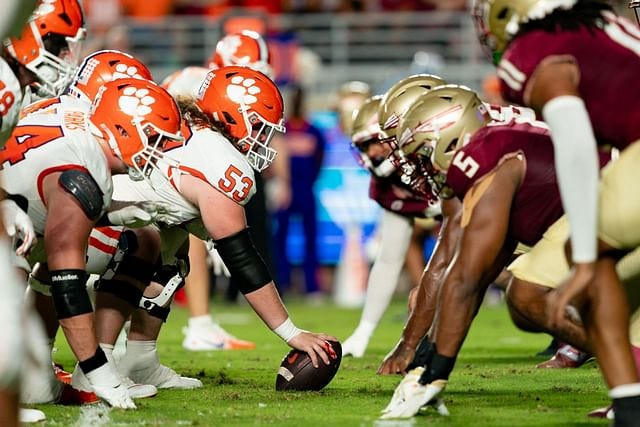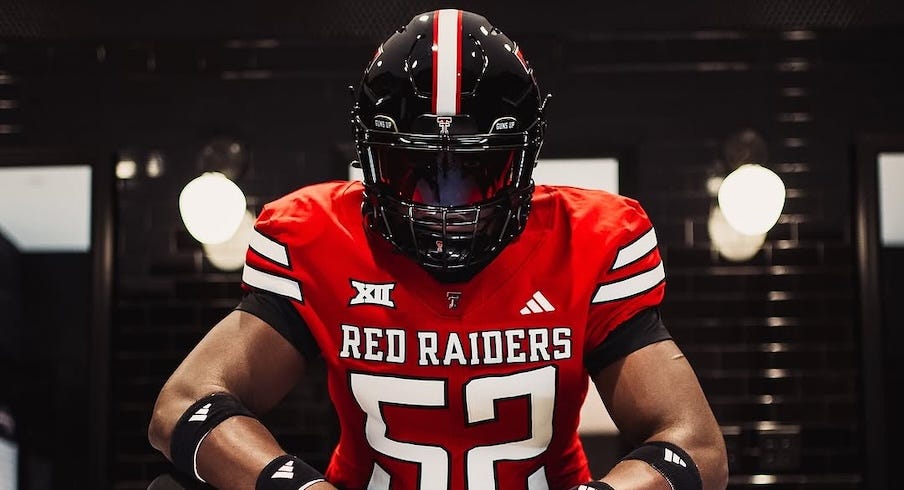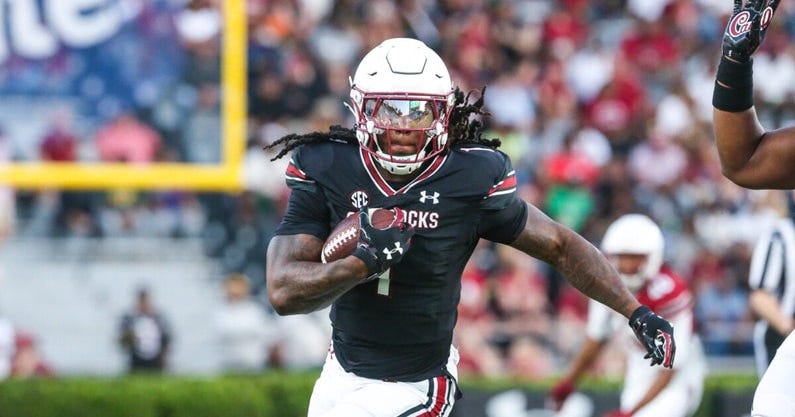LSU Plans To Sell Jersey Advertisement Patches, Exit Fees in the ACC, Texas Tech Commit, & More | NIL Newsletter #343
Welcome to the NIL Newsletter by Optimum Sports Consulting - providing valuable, actionable NIL resources for athletes, administrators, agencies and other sport professionals.
Keep up to date on all of our newsletters and content by checking out past Optimum Sports Consulting Newsletters and following us on Twitter!
This Monday Newsletter Includes:
1. LSU Plans to Sell Jersey Advertisement Patches
2. ACC Settlement Details Unveil Exit Fees and New Revenue Structure
3. Texas Tech’s $5 Million Deal for Five-Star OT
4. Quick Hitters
5. Legal Updates and What’s Coming Up for NIL
🏆Major News
LSU Plans to Sell Jersey Advertisement Patches
LSU is aiming to become the first major athletic department to monetize jersey space through sponsor patch advertisements, pending formal approval from the NCAA . The Tigers anticipate the move could generate "multiple millions of dollars annually," positioning it as a significant new revenue stream within the NIL landscape.
The plan has been fully mapped out across every sport, with designs placing patches primarily on the chest area of uniforms, rendered in LSU’s traditional purple and gold to maintain visual consistency. The proposal spans all varsity sports from football and basketball to cross country and volleyball.
School officials emphasized they intend to keep the aesthetic "clean," rejecting a "NASCAR-like" appearance with excessive branding. The approach aims to strike a balance between commercial viability and institutional image, ensuring patches remain discrete and dignified.
LSU’s proposal comes amid a broader shift in NCAA policy. In 2023, the association approved on-field sponsorship logos, and many programs, including those in the SEC, began leveraging that space during regular-season games.
Jersey patch advertisements have been a topic of interest among athletic directors and conference executives for over a year. Many see it as the next logical evolution in college sports monetization, citing successful models in professional leagues.
SEC Commissioner Greg Sankey has previously acknowledged the inevitability of further commercialization, noting that jersey patches are already permitted during bowl games and predicting continued innovation around new revenue channels in college athletics
ACC Settlement Details Unveil Exit Fees and New Revenue Structure
A new settlement between the ACC and member schools Florida State and Clemson has revealed the year-by-year exit fee structure for programs considering conference realignment, with the 2025–26 fee set at $165 million. According to a July 3 report by On3’s Brett McMurphy, the exit cost decreases incrementally to $75 million by 2030.
The figures are tied to a broader agreement that resolves lawsuits filed by both schools, which challenged the ACC’s media rights and grant of rights contracts. Florida State questioned the enforceability of the grant of rights, while Clemson sought clarification over control of its broadcast content.
Under the new terms, schools will retain their media rights after paying the exit fees. Additionally, the ACC will implement a revised revenue distribution model centered around television viewership and success-based incentives.
The model shifts 60 percent of base media rights revenue into a “viewership pool,” which will now be distributed based on rolling TV ratings averages, effective immediately. This aims to reward programs generating stronger audience engagement.
Clemson’s board of trustees projected that the settlement could yield more than $120 million in new revenue over six years, citing the combined effects of the new distribution model and enhanced conference success initiatives.
Florida State trustee Drew Weatherford praised the outcome, stating that institutional pressure to consider exiting the ACC was instrumental in driving reforms. He described the result as transformative for Seminole athletics and a long-term win for all stakeholders.
Texas Tech’s $5 Million Deal for Five-Star OT
Texas Tech has made national headlines after landing five-star offensive tackle Felix Ojo through what could be one of the most lucrative direct-pay contracts yet under the NCAA’s new revenue-sharing system. ESPN reported on July 5 that Ojo signed a fully guaranteed three-year deal worth $5.1 million, turning down offers from Texas, Ohio State, Michigan, and Florida.
Ojo’s agent Derrick Shelby confirmed the contract value to ESPN, while The Athletic published a conflicting report citing Texas Tech sources who valued the agreement at $775,000 annually, or $2.3 million over three years. The discrepancy underscores widespread confusion over how payments will be structured and capped during the system’s rollout.
The Red Raiders have been among the most aggressive programs in the new era. The university reportedly spent over $10 million on 17 football players during the winter transfer portal period, and continues to make bold investments in infrastructure and personnel.
In early 2025, Texas Tech opened the $242 million Womble Football Center, a 340,000-square-foot training facility described as one of the most advanced in college football. The move signaled a clear intent to be a frontrunner in the new pay-for-play environment.
Cody Campbell, co-founder of the Matador Club NIL collective, told The Athletic in June that the school expects to allocate $55 million in NIL and revenue-sharing payments across all sports next year, positioning it as one of the highest-spending athletic departments in Division I.
The school’s investment in Ojo, combined with a deep NIL war chest, illustrates the beginning of a high-stakes arms race. The early days of direct compensation are already revealing gaps in enforcement and inconsistencies in financial disclosures across programs.
📌Other Notable Stories to Follow
Pac-12 Eyes Basketball Boost in Media Talks – Commissioner Teresa Gould said basketball could play a central role in the Pac-12’s next media rights deal, citing strong interest in Gonzaga, San Diego State, and other programs as potential value drivers. 🔗 LINK
USC’s Waymond Jordan Signs with Niagara Water – Top JUCO transfer and NJCAA Offensive Player of the Year Waymond Jordan adds Niagara Water to his NIL portfolio, joining other Trojan alumni as brand ambassadors. 🔗 LINK
Jeremiah Smith Joins Adidas Football – Ohio State star wide receiver Jeremiah Smith, signed an NIL deal with Adidas ahead of his sophomore season after helping the Buckeyes, a Nike school, win the national title. 🔗 LINK
Coach Freeze Voices Opinion on Revenue Sharing– Auburn coach Hugh Freeze says revenue-sharing is changing the recruiting focus towards retaining current players. With a $20.5 million athlete pay cap, Freeze notes that roster retention is key. 🔗 LINK
📅What’s Coming Up Next for NIL
July 26: EA Sports to release "College Football 26" with increased NIL compensation for players
⚖️Legal Updates
Eligibility Waiver Delay Puts South Carolina RB Rahsul Faison’s College and NFL Future in Legal Crosshairs
South Carolina running back Rahsul Faison has been waiting nearly six months for a crucial NCAA eligibility waiver decision after transferring from Utah State, delaying his ability to play in the upcoming college football season.
Despite having only played three collegiate seasons, Faison has exhausted the NCAA’s standard five-year eligibility clock, prompting his camp to seek a waiver that would extend his eligibility period.
This waiver pursuit is influenced by a recent landmark legal victory by Vanderbilt quarterback Diego Pavia, who successfully challenged the NCAA’s eligibility rules in federal court on antitrust grounds, specifically regarding how junior college seasons are counted toward eligibility.
Faison’s legal team, led by prominent NIL attorney Darren Heitner, argues that the NCAA’s rigid five-year eligibility clock unfairly penalizes players like Faison and seeks a modification that would reset or adjust the start of his eligibility period based on his unique circumstances.
The NCAA has yet to issue a ruling, despite South Carolina providing all requested documentation since January, leading to mounting frustration for both the player and the institution.
South Carolina head coach Shane Beamer publicly expressed disappointment with the NCAA’s delay, highlighting the impact of the indecision on team roster planning.
While awaiting the NCAA’s decision, Faison is actively preparing for the 2025 college season, training daily as if he will be cleared to compete.
As a contingency plan, Faison is also preparing to enter the NFL supplemental draft or sign as an undrafted free agent if the waiver is denied, aiming to continue his professional career without further delay.
His physical readiness is notable, with reports of a 4.4-second 40-yard dash and projections as a mid-round pick in the 2026 NFL draft.
This ongoing case underscores the growing legal scrutiny of NCAA eligibility rules and their potential violation of antitrust laws, reflecting broader challenges to collegiate athletics governance and athlete rights.
The outcome of Faison’s waiver request could set important precedents for how eligibility is calculated and enforced, particularly for transfers and junior college athletes.
Thanks for Reading!
Keep up to date on all of our newsletters and content by checking out past Optimum Sports Consulting Newsletters and following us on Twitter!










